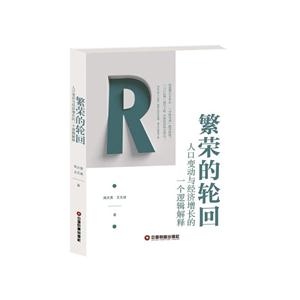-
>
妙相梵容
-
>
基立爾蒙文:蒙文
-
>
我的石頭記
-
>
心靈元氣社
-
>
女性生存戰爭
-
>
縣中的孩子 中國縣域教育生態
-
>
(精)人類的明天(八品)
繁榮的輪回:人口變動與經濟增長的一個邏輯解釋 版權信息
- ISBN:9787504764355
- 條形碼:9787504764355 ; 978-7-5047-6435-5
- 裝幀:70g輕型紙
- 冊數:暫無
- 重量:暫無
- 所屬分類:>>
繁榮的輪回:人口變動與經濟增長的一個邏輯解釋 本書特色
自2008年以來,中國經濟中的“人口紅利”消耗殆盡,每年8%以上增速的“中國奇跡”風光不再。未來15-20年,中國經濟能否保持中高速增長?通過調整人口政策,能給經濟增長帶來哪些新動力?本書以獨特的視角,從研究中國經濟發展的“人口因素”入手,借鑒世界各國經驗教訓,揭示了中國經濟下行的深層次原因,提出了中國人口政策方面的“生育管制”和“流動管制”帶來的各種不利經濟增長的后果,為各級政府制定促進經濟增長的經濟政策與改革方案,提供了一條嶄新的思路。
繁榮的輪回:人口變動與經濟增長的一個邏輯解釋 內容簡介
本書以獨特的視角, 從研究中國經濟發展的“人口因素”入手, 借鑒世界各國經驗教訓, 揭示了中國經濟下行的深層次原因, 提出了中國人口政策方面的“生育管制”和“流動管制”帶來的各種不利經濟增長的后果, 為各級政府制定促進經濟增長的經濟政策與改革方案, 提供了一條嶄新的
繁榮的輪回:人口變動與經濟增長的一個邏輯解釋 目錄
1問題的起因/00
11中國奇跡:經濟高速增長30年/00
111經濟實力快速增長/00
112從農業經濟社會向現代工業社會的轉型/00
113對外貿易的“引進來”和“走出去”/00
114人民生活從溫飽到小康/0
12中國經濟高速增長的成因/0
121高生育率積蓄了大規模的剩余勞動力/0
122剩余勞動力優勢成功嵌入全球產業鏈/0
123經濟主力人口的創業創新動力/0
132008年經濟增速開始下行/0
131工業生產轉入了全面過剩/0
132消費、投資增速下行和突然放緩/0
133傳統的出口優勢逐步趨弱并已消失殆盡/0 2經濟下行的“兩家爭鳴”與質疑/0
21經濟本不應進入中速增長階段/0
211“中速增長常態論”的邏輯推理和政策主張/0
212對“中速增長常態論”的商榷/0
22經濟下行不是外因所致/0
221“增速下行外因論”的邏輯推理和政策主張/0
222對“增速下行外因論”的商榷/0
目錄第2部分學術爭論與歷史演變
3人口與發展:理論述評與事實/0
31人口與經濟關系理論的回顧與評述/0
311適度人口論與人口控制主張/0
312《增長的極限》與人口資源悲觀論/0
313市場機制調控家庭生育決策的基本過程/0
314人口流動與經濟增長關系的研究述評/0
32人口增長與工業化發展/0
321人口增長是工業化的必要條件/0
322人口增長方式轉型也是工業化的產物/0
33人口流動、城市化及工業化發展/0
331人口流動加速城市化的進程/0
332城市化與工業化發展的互動/0
34人口、工業化與生態環境的動態協調發展/0
341人口增長與資源的協調發展/0
342人口、工業化與環境的協調發展/0
343人口、工業化與生態環境的動態發展/0 4生育權與遷移權/0
41生育權與遷移權的界定/0
411生育權在個人和國家間的歸屬之爭/0
412遷移權在個人與國家間不同的安排/0
42 生育權的經濟學分析/
421生育權的經濟學解釋/
422生育權行使的經濟學探討/
43 遷移權的經濟學分析/
431遷移權的經濟學解釋/
432遷移權行使的經濟學探討/ 5 世界經驗:基于不同生育權和遷移權的配置/
51 基于不同生育權配置的國際經驗/
511美國不干預的生育及經濟發展/
512日本指導性計劃生育與經濟的先富后低/
513韓國指導性計劃生育歷程/
514中國臺灣地區的指導性計劃生育/
515計劃生育政策在印度的流產 /
516不同生育權配置的國際經驗總結/
52 基于不同遷移權配置的國際經驗/
521美國的人口遷移自由/
522日本的人口遷移和住民登記/
523法國的遷移自由和流動人口管理/
524俄羅斯人口遷移及其低流動性/
525印度的人口遷移與貧民窟的形成/
526不同遷移權配置的國際經驗總結/
第3部分中國人口生育管制的經濟后果
6 “人口坑”與經濟增長的陷阱/
61 “人口坑”深淺與經濟高增長時間的長短/
611工業化階段的“人口坑”與經濟增長速度/
612中國“人口坑”與經濟增長速度放慢/
62 人口增長變動對經濟增長速度的影響/
621即期影響:人口增長對經濟增長的影響/
622長期影響:人口變動的20年延期影響定理/ 7 人口結構失衡和老齡化的經濟后果/
71 人口結構與經濟排浪式變動及增長波動/
711人口變動與消費、投資和出口變動的數理關系/
712人口變動引致國民經濟排浪式衰退/
72 未來經濟長期承受的下行和老齡化壓力/
721國民經濟未來長期面臨的下行壓力/
722未來老齡化加劇的諸多難題/
第4部分中國人口流動管制的經濟后果
8 人口進入城市和退出農村的障礙和問題/
81 流動人口市民化的進入障礙/
811中國戶籍管理制度變遷與人口流動/
812社會保障與公共服務的不公平/
82進城農民工人口的農村財產退出障礙/
821農民理性經濟人與退出資產障礙和機會成本/
822出租退出困境與其他退出方式比較/
823農地制度復雜性與建設征用為國有之弊/ 9 城市化流程的扭曲和消費塌陷/
91 “青出老回”與漂泊于城市/
911人口城鄉鐘擺式和不同地頻繁流動/
912人口從農村到城市的“青出老回”/
913不返鄉的農民工人口在城市中漂泊/
914大多數國家能夠市民化的城市化/
92城市消費抑制和農村消費塌陷/
921流動人口干預制度下的城市消費抑制/
922“青出老回”流程與農村消費塌陷/
結束語/
參考文獻/
0000
PART ONEThe Unsolved Mystery in China’s Economic Community
1Origin of the Problem/ 00
11Chinese Miracle: The 30 Years of High Economic Growth Rate/ 00
111Rapid Growth of Economic Strength/ 00
112Transition from Agricultural Economy to Modern Industrial Economy/ 00
113“Bringing In” and “Going Out” of International Trade/ 00
114From Subsistence to Moderate Prosperity/ 0
12The Reasons of China’s High Economic Growth/ 0
121High Fertility Rate Saving Huge Surplus Labor/ 0
122Successfully Integrating Surplus Labor Advantage into Global Industrial Chain/ 0
123Entrepreneurship and Innovation by Population as Major Economic Force/ 0
13The Slowdown of Economic Growth Since 2008/ 0
131Industrial Product Turning into Overall Surplus/ 0
132Downturn and an Abrupt Slowdown of Consumption and Investment/ 0
133Traditional Export Advantage Exhausting Gradually/ 0
2Two Theories of Economic Downturn and Doubts/ 0
21The Economy Should Not Enter Intermediate Speed of Growth/ 0
211The Logic and Policy View of “Medium Growth as Normal”/ 0
212Discussion over “Medium Growth as Normal”/ 0
22Economic Downturn Is Not Caused by External Factors/ 0
221The Logic and Policy View of “External Causes of Economic Downturn”/ 0
222Discussion over “External Causes of Economic Downturn”/ 0
Contents
PART TWOAcademic Debate and Historical Evolution
3Population and Development: Theoretical Review and Facts/ 0
31The Review and Discussion of the Relationship Theory of Population and Economy/ 0
311Moderate Population Theory and Its View of Birth Control/ 0
312“The Limits to Growth” and Pessimistic View of Population and Resources/ 0
313Basic Process of Family Planning under Market Mechanism/ 0
314Reviews of Literature on Population Mobility and Economic Growth/ 0
32Population Growth and Industrial Development/ 0
321Population Growth as Necessity of Industrialization/ 0
322Transition of Population Growth as Outcome of Industrialization/ 0
33Population Flow, Urbanization and Industrial Development/ 0
331Population Mobility Speeding up Urbanization Process/ 0
332Interactions between Urbanization and Industrialization/ 0
34The Dynamic and Coordinated Development of Population, Industrialization and Ecological Environment/ 0
341Harmonious Development between Population Growth and Resources/ 0
342Harmonious Development among Population Growth, Industrialization and Ecological Environment/ 0
343Dynamic Development among Population Growth, Industrialization and Ecological Environment/ 0
4Reproductive Right and Migration Right/ 0
41The Definition of Reproductive Right and Migration Right/ 0
411Dispute over ownership of Reproductive Right between Family and Government/ 0
412Different Arrangement of Migration Right between Family and Government/ 0
42The Economic Analysis of Birth Rate/
421Economic Explanation of Reproductive Right/
422Economic Discussion over Exercise of Reproductive Right/
43The Economic Analysis of Migration Right/
431Economic Explanation of Migration Right/
432Economic Discussion over Exercise of Migration Right/
5Experience in the World: The Distribution Based on Different Reproductive Right and Migration Right/
51The International Experience Based on Different Reproductive Right/
511Nonintervention Experience of the United States/
512Instructive Birth Control in Japan and Its Economic Up and Down/
513History of Instructive Birth Control in Korea/
514Instructive Birth Control in Taiwan/
515Miscarriage of Birth Control in India/
516International Experience of Different Arrangement of Reproductive Right/
52The International Experience Based on Different Migration Right/
521Free Migration of Population in the United States/
522Reproductive Right and Residential Registration in Japan/
523Free Migration of Population and Floating Population Management in France/
524Migration of Population and Low Mobility in Russia/
525Migration of Population and Formation of Slum Problem in India/
526International Experience of Different Arrangement of Migration of Population/
PART THREEThe Economic Consequence of China’s Population Planning System
6“Population Pit” and the Trap of Economic Growth/
61The Depth of “Population Pit” and The Time Length of High Economic Growth/
611“Population Pit” at Industrialization Stage and Economic Growth/
612“Population Pit” and Economic Slowdown in China/
62The Influence of the Change of Population Growth on Economic Growth Rate/
621Immediate Influence: Population Growth over Economic Growth/
622Long-term Influence: Theory of 20-year Delay Effect of Population Growth/
7The Economic Consequence of Unbalanced and Aging Population Structure/
71Population Structure, Huge Economic Change and the Fluctuation of Increase/
711Arithmetical Relationship between Population Structure and Consumption, Investment and Export Fluctuation/
712Population Change Leads to National Economic Downturn as Waves/
72The Downward and Aging Pressure on Economy in the Future/
721Long-term Economic Downward Pressure of National Economy/
722Numerous Difficulties from Aggravating Population Aging/
PART FOURThe Economic Consequence of China’s Population Flow Regulation System
8The Barriers and Problems of Population Entering Cities and Exiting Rural Areas/
81The Entry Barriers of theCitizenization of Migrant Population/
811Transition of Household Registration System and Population Movement in China/
812Inequality of Social Securities and Public Services/
82The Exit Barriers of Rural Property for Migrant Workers in Cities/
821Exit Barriers and Opportunity Cost for Farmers as Rational Economic Man/
822Dilemma of Renting to Exit and Comparison with Other Methods/
823Complexity of Rural Land System and Fraud of Acquisition as State-owned/
9The Twist of Urbanization Process and Consumption Downfall/
91“Out at Young Age and Return at Old Age” and Drifting in Cities/
911Frequent Migration of Population among Multiple Destinations between Rural and Urban Areas in Pendulum Mode/
912Population Migration between Rural and Urban Areas as “Out at Young Age and Return at Old Age”/
913Drifting Migrant Workers in Cities instead of Returning to Rural Areas/
914Urbanization with Citizenization in Most Countries/
92The Restriction on Urban Consumption and the Downfall of Rural Consumption/
921System with Intervention over Floating Population Which Restraining Consumption/
922Process of “Out at Young Age and Return at Old Age” and Consumption Downfall in Rural Areas/
Conclusion/
References/
繁榮的輪回:人口變動與經濟增長的一個邏輯解釋 作者簡介
周天勇,經濟學博士,教授,中共中央黨校國際戰略研究所副所長,中共中央黨校校委研究室副主任,北京科技大學博士生導師。 社會兼職有:中國城市發展研究會副理事長兼城市研究所所長,國家行政學院、北京科技大學、東北財政大學、中國社會科學院研究生院等教授,國家發改委價格咨詢專家。研究領域為社會主義經濟理論、宏觀經濟、經濟發展和增長、勞動經濟、中小企業、金融風險、城市化、國企改革、農業經濟等。在上海三聯出版社、經濟科學出版社和中共中央黨校出版社出版有《勞動與經濟增長》、《效率與供給經濟學》、《金融風險與資本社會化》、《中國經濟命運與前景的深層次思考》、《新發展經濟學》、《中國政治體制改革》、《國有企業改革攻堅》、《現代國有資產管理體系模式》、《走出決策的經濟誤區》、《走出發展的體制障礙》、《中國:經濟運行與結構轉換》和研究生用《高級發展經濟學》等專著和教材。近年來就國家整體負債、公平與效率、政府各部門收費、財政體制、官民供養比、水電開發、中國增長的危機等方面發表的文章,引起了各方面的高度關注。
王元地,男,四川大學教授,中共黨員。2012年以“人文社科青年百人計劃” 引進人才進入四川大學工作,聘為副研究員,2014年破格聘為博士生指導教師,并擔任四川大學創新與創業管理研究所常務副所長,入選四川省學術和技術帶頭人后備人選,2015年破格晉升教授。研究方向為:技術許可和交易、知識產權保護、企業創新國際化和后發國家技術追趕。作品有:《中國自主創新政策評價研究》(獨著)、《中國區域創新體系發展的理論與實踐》(合著)、《現代企業理論》(聯合主編)、《戰略管理理論與實踐》(主編)等。
- >
史學評論
- >
莉莉和章魚
- >
山海經
- >
我從未如此眷戀人間
- >
羅庸西南聯大授課錄
- >
月亮虎
- >
名家帶你讀魯迅:朝花夕拾
- >
中國人在烏蘇里邊疆區:歷史與人類學概述

















